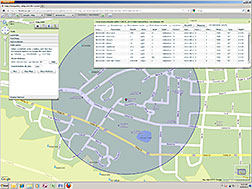- Number 389 |
- May 27, 2013
Millions of environmental records available to the public

Millions of environmental records available
to the public.
Today, instant access to information is taken for granted. The national labs are no exception; local data users expect immediate access to their data. DOE's Los Alamos National Laboratory (LANL) made its twelve million environmental data records accessible to scientists, remediation teams and the public at a mouse click.
LANL successfully integrated all of the environmental data into a single, cloud-based, web-accessible system combining transparency to the public with the immediate access required by technical staff at www.intellusnmdata.com.
The newly integrated data span a wide range of media including air, soil, sediment, biota, and water; various analytes, time periods and varying formats that were formerly contained in scattered databases. The unconsolidated information made comprehensive work with the data impossible.
The implementation of automatic electronic data validation was also a critical step to affect immediate data access while saving millions of dollars and increasing data consistency and quality.
The integrated Google Maps-based GIS tool is simple enough for people to locate sampling sites near their home or workplace, and complex enough to allow scientists to plot and trend their data at the surface, and across time.
A variety of formatted reports can be run at any desired frequency to provide the most current data available. Advanced users can run queries to pick out more specific information.
According to Karen Schultz Paige, program manager for the Intellus system, “The system has met all of our requirements. Four different environmental databases have been combined for the first time into one publicly accessible database. It’s nice to see it all come together and work so well for the public while serving our environmental scientists in the process.”
Concept Grows from the Flames
The concept for the system began when integrated environmental data was needed for a site risk assessment following the Cerro Grande forest fire, which burned a significant area around the nearly 40-square-mile laboratory site in 2000.
Subsequently, LANL made environmental data available to the public through a web-server-based system so they could find pre- and post-fire sampling information around LANL and in the surrounding communities.
A 2010 process-improvement study (from sample collection through submission of samples to the analytical lab and receipt of the electronic data uploaded into the database) found several obstacles within the data flow as well as slow delivery of information to the public.
Incorporating needed improvements; Intellus was born. It ensures that the public has access to the most recent and exact same data that scientists are using to make environmental stewardship decisions.
Cloud-Based Data
The cloud-based data system now houses more than twelve million records including 27,000 locations and 250,000 samples. The requirements from the study were met and a host of additional desired features added:
• a publicly available view of the database requiring no feeds or transformations of the data,
• automatic electronic validation of all data upon upload,
• reduction in cost with an increase of uptime,
• free form querying, so that scientists can use their data fully,
• ability to design new reports,
• accommodation of new data providers,
• the ability to plan data from various sampling campaigns,
• graphical display of data on maps,
• sample tracking from planning through collection, submission, and upload,
• and invoice improvements that match costs to sample methods.
Security of the cloud-based system is ensured through the use of a Tier IV data center, which is the highest level of security and accessibility available. The data center is protected against power and communication failures and environmental and cybersecurity attack and redundant backups ensure seamless data protection and the highest level of uptime.
For data that moves through the entire data process but is not environmental monitoring data, such as industrial hygiene data associated with facilities and personnel or research data, a non-environmental site is available.
For data collected for third parties, such as local or tribal entities, the data can be held for a review period before it is released to the public. Over a thousand unique users have accessed the public
The New Mexico Environment Department – Oversight Bureau has already loaded their environmental data into Intellus. Intellus has the capacity for other neighboring cities, state agencies, or tribal facilities to enter their data into the data base, while maintaining data control and access.
Although LANL’s environmental data is made available to the public, LANL adheres to FISMA, the Federal Information Security Management Act, to ensure the security of data is not compromised. – Lorrie Bonds Lopez[Nancy Ambrosiano, 505.667.0471,
nwa@lanl.gov]
